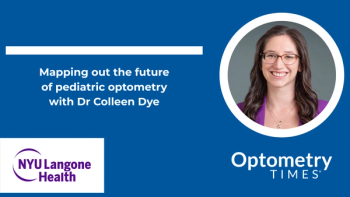
Spectral-domain optical coherence tomography used to sort pathologies
Spectral-domain optical coherence tomography is an ideal tool for retinal layer-by-layer analysis and is revolutionizing the identification and localization of various retinal pathologies.
Key Points
Dr. Biffi's research was performed at State University of New York (SUNY) College of Op-ometry, New York City, under the mentorship of Dr. Jerome Sherman, OD, FAAO.
Distinguishing characteristics of five different drusen-related pathologies (hard cuticu-lar drusen, hard infiltrative drusen, subretinal drusen deposits, soft drusen, and geographic atrophy) were identified through retrospective review of 52 images containing drusen that were selected from a series of 1,200 SD-OCT scans acquired in patients seen at SUNY College of Optometry, using one commercially available SD-OCT device (3DOCT-2000, Top-con Medical Systems Inc.).
"Although different types of drusen are composed of similar components, including lipid, lipofuscin, and inflammatory mediators, they can be distinguished by their unique reflective characteristics on SD-OCT images," said Dr. Biffi, associate clinical professor, New England Eye, Boston. "In addition, clinicians can apply the information about retinal structure to understand visual function. This is important for practitioners, as we need to determine if the visual acuity in our patients with dry AMD correlates with the disease severity."
Dr. Biffi reviewed the findings of her research, and explained the various categories of drusen that were seen.
Hard cuticular drusen are seen on as discrete deposits below the RPE, causing dome-shaped elevations of the RPE layer. The PIL is generally intact, except at the peak of the dome where it is thinner than in the normal retina. Since the PIL is present but attenuated, visual function will only be slightly decreased. A case presented by Dr. Biffi involved a patient with DVA cc 20/25-.
Hard infiltrative drusen appear as multiple discrete deposits. Like hard cuticular drusen, they are also located under the RPE. However, per their name, hard infiltrative drusen infiltrate through both the PIL and RPE, disrupting both layers. Loss of RPE also allows visibility of Bruch's membrane in eyes with hard infiltrative drusen, which is not the case in normal retina where Bruch's membrane is "masked" by reflection from intact RPE. DVA cc in a patient who presented with hard infiltrative drusen was only 20/4000.
"Visual function is dramatically reduced in patients with hard infiltrative drusen due to the lack of the PIL and RPE layers. In addition, progressive vision loss is particularly likely in patients with this type of drusen, and so they are patients who should be followed closely and frequently," Dr. Biffi said.
Subretinal drusenoid deposits appear as conical structures in SD-OCT imaging, but they are less elevated than the hard drusen. Localized between the RPE and PIL layers, subretinal drusenoid deposits do not compromise the integrity of the RPE, PIL, or outer limiting membrane layers of the retina, and vision remains good in patients with this type of drusen.
Soft drusen have a classical appearance of a pigment epithelium detachment. They are seen as large, sub-RPE mounds, but compared with hard cuticular drusen, there is less reflective material inside these deposits. The integrity of the PIL layer varies along the outline of the deposit.
The PIL is present along the base of the mound, but becomes highly attenuated and compromised moving up the sloping sides to the top. The RPE is compromised, and so there is enhanced visibility of Bruch's membrane. Visual acuity is reduced because of the attenuation in the PIL. DVA cc in a patient presenting with soft drusen was 20/80.
Newsletter
Want more insights like this? Subscribe to Optometry Times and get clinical pearls and practice tips delivered straight to your inbox.



















































.png)


